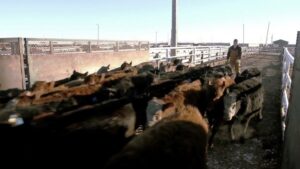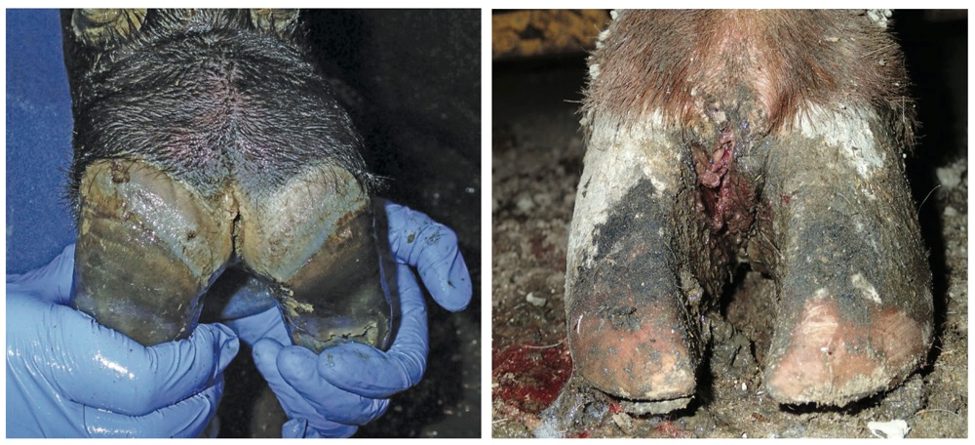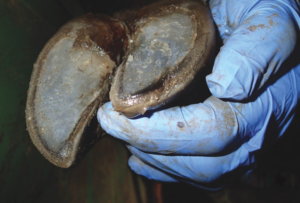Don’t be Lame – New Web Page with Resources for Preventing and Managing Lameness in Beef Cattle

Not all lameness is caused by foot rot. Getting a proper diagnosis is the key to determining the appropriate treatment and management for any lameness condition. Lameness can affect any type of cattle including feedlot animals, breeding bulls, range cows, or animals confined to a corral. It limits an animal’s interest in eating, drinking, or breeding resulting in lower weight gains and conception rates, making it an animal health and welfare concern, as well as a production and economic issue.
A 2019 study reported that lameness is the leading cause for health treatments in breeding cows and bulls. However, diagnosing lameness isn’t always straightforward as the condition can be caused by multiple inter-related factors. Another recent feedlot study analysed health records from 28 different western Canadian feedlots over a ten-year period to determine common lameness conditions. Overall, lameness was diagnosed in 4.4% of steer and 4.7% of heifer placements. Comparing diagnoses by class of cattle, 4.9% of calves were diagnosed with lameness compared with 4.0% of yearlings. Of the lameness diagnoses, foot rot was most common at 74.5% of lameness cases, followed by joint infections at 16.1%, then lameness with no visible swelling at 6.1%, followed by lameness due to injury 3.1%.
The analysis also demonstrated that there may be some risk factors. Fall- and winter-placed calves were at a greater likelihood of being diagnosed with foot rot compared to yearlings. The study showed health status was a risk factor. Cattle diagnosed with lameness due to injury, joint infection, or lameness with no visible swelling were associated with a diagnosis of Bovine Respiratory Disease (BRD). In another study, researchers found that lameness accounted for 37.4% of cattle in the chronic illness pen, with another 10.9% of cattle being diagnosed with both respiratory disease and lameness. Transport is also a factor and can make any lameness issues worse. Healthy and fit cattle are at a low risk for lameness caused by transport, however a 2008 survey reported that market cows were at a greater risk for lameness than fed cattle, feeders, or calves and the likelihood of lameness increased with the duration of transport.
There are four common general causes of lameness:
- Infection (i.e. foot rot, digital dermatitis, toe tip necrosis, infectious arthritis);
- Nutrition (i.e. laminitis, mycotoxin-related necrosis);
- Physical injury (i.e. frostbite, sprain, break);
- Genetics (i.e. bad conformation, temperament).
Infections can be difficult to diagnose, particularly because some are well understood, and some are not.
Producers should not assume that lame cattle have foot rot without close observation, to avoid unnecessary antibiotic usage.
Foot rot is often characterized by a sudden onset of lameness and is worse during wet conditions. People sometimes assume any lameness is caused by foot rot however this is not true. Foot rot is highly infectious and is typically caused by Fusobacterium necrophorum bacteria. The infection originates in between the claws of the hoof and may be characterized by heat and swelling in between the claws, as well as along the coronary band where the hoof meets the skin. If it is not identified and treated promptly, the infection can cause complications however foot rot infections almost always respond well to treatment.

Foot rot infection demonstrating infected tissue between the claws. Photo courtesy of Eugene Janzen and team.

Toe tip necrosis is a lameness condition affecting the hind feet of feedlot cattle and research and information is emerging. It develops early in the feeding period, and often occurs within cohorts of animals. Sometimes referred to as a toe abscess or ulcer, apical white line disease, or P3 necrosis, it has been associated with improper processing, poor handling, abrasive flooring, or flighty animal behaviour. Careful, low-stress handling and proper flooring may help prevent the development of toe tip necrosis. The symptoms of toe tip necrosis can be similar to injury, making it challenging to obtain a definitive diagnosis, as discussed in a recent webinar (click to watch the recording start at 41:20).
Digital dermatitis, also known as hairy heel wart or strawberry foot rot, is a skin infection that affects the area around the dewclaws, between the claws, and sometimes the heel of the hooves. The disease is characterized by raised, painful lesions that are red and bleed easily if disturbed, and some have long fibrous hairs. Animals appear to walk on their tip toes to avoid putting pressure on their heels. Digital dermatitis is highly infectious but doesn’t respond well to injectable antibiotic treatment. Once an animal is infected with Treponema, the organism primarily associated with digital dermatitis, the animal will have it for life. To complicate things, digital dermatitis may occur simultaneously with foot rot.
Digital dermatitis is being increasingly diagnosed in confined beef cattle. A recent webinar discussed the prevalence in Ontario, where veterinarians are seeing the disease appear (watch the recording, starting at 26:53).
While lameness can be an overwhelming problem, there are many useful management practices producers can implement to help reduce lameness, including:
- regular pen cleaning and landscaping to ensure proper drainage, good footing, and minimal build-up of manure and bacteria that causes lameness (i.e. Fusobacterium necrophorum);
- disinfecting and maintaining hoof-trimming equipment and tools;
- removing sharp objects, such as rocks, ice, wire or metal, that may cause injury;
- vaccinating/preconditioning cattle to reduce disease and improve overall health and immunity in order to minimize risk of lameness as a secondary ailment;
- practicing low-stress animal handling;
- incorporating proper handling facility designs that include adequate traction and comfortable footing;
- applying lime to barn floors following cleaning between fills to make the environmental pH less friendly to infectious lameness-causing bacteria;
- consulting with your veterinarian regarding the potential use of a Fusobacterium necrophorum vaccine to prevent foot rot;
- incorporating step-up rations for high-grain diets to reduce the risk of acidosis and laminitis;
- testing feeds for potential mycotoxins that may lead to ergot poisoning;
- carefully inspecting feet and legs on breeding cattle to ensure they are fit and sound;
- prior to transport, carefully considering whether animals are suited for shipping. Market cows are at a greater risk for lameness and injury during transport.
You can learn more about lameness caused by injury, nutrition, or genetics, as well as ongoing research, by visiting the Lameness topic page.
Learn More:
- Digital Dermatitis (BCRC webinar)
- Toe Tip Necrosis (BCRC webinar)
- Toe Tip Necrosis Syndrome (BCRC Blog)
- Transport (BCRC web page)
- Acidosis (BCRC web page)
- Mycotoxins (BCRC web page)
Click here to subscribe to the BCRC Blog and receive email notifications when new content is posted.
The sharing or reprinting of BCRC Blog articles is welcome and encouraged. Please provide acknowledgement to the Beef Cattle Research Council, list the website address, www.BeefResearch.ca, and let us know you chose to share the article by emailing us at info@beefresearch.ca.
We welcome your questions, comments and suggestions. Contact us directly or generate public discussion by posting your thoughts below.